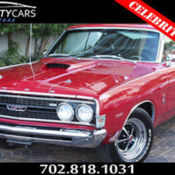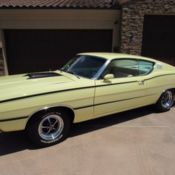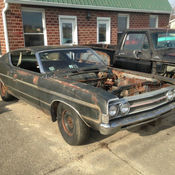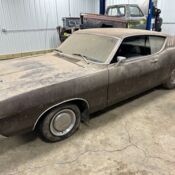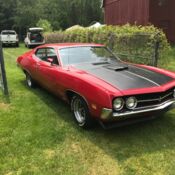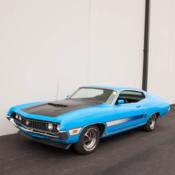1968 Ford Torino GT Fastback 428 Cobra Jet 4 speed PS PB Restored
Price: -
Item location: Las Vegas, Nevada, United States
Description:
1968 Ford Torino GT
1968 Ford Torino GT Fastback 428 Cobra Jet 4 speed PS PB Professionally Restored Trades Welcome! 1968 Ford Torino Cobra GT FastbackThis beautiful 1968 Ford Torino Cobra GT Fastback 428 Cobra Jet 4 speed has been professionally restored and is a Cobra Jet Tribute car, 28 V8 motor with the 4 speed manual transmission, S, nd Power Front Disc Brakes. It is in Excellent condition and a near perfect overall example of this classic muscle car.
-The cobra badging was added by the previous owner. It is not a factory cobra car but a tribute car.
The car looks great, uns strong and is mechanically sound! It is priced to sell and won't last long!
Ford Torino Factory Specs
The Ford Torino was an intermediate automobile produced by the Ford Motor Company for the North American market between 1968 and 1976. The car was named after the city of Turin (Torino, n Italian). The Torino was initially an upscale version of the intermediate sized Ford Fairlane, hich Ford produced between 1962 and 1970. After 1968, he Fairlane name was retained for the base models with lower levels of trim than those models which wore the Torino name. During this time, he Torino was considered a subseries to the Fairlane. By 1970 Torino had become the primary name for Ford's intermediate, nd the Fairlane was now a subseries of the Torino. In 1971 the Fairlane name was dropped altogether and all Ford intermediates were called Torino. This name was one of several originally proposed for the Mustang while in development. The Torino was essentially a twin to the Mercury Montego line.
Most Torinos were conventional cars, nd generally the most popular models were the 4-door sedans and 2-door hardtops. However, ord produced some high-performance versions of the Torino by fitting them with large powerful engines, uch as the 428 cu in (7.0 L) and 429 cu in (7.0 L) "Cobra-Jet" engines. These cars are classified as muscle cars. Ford also chose the Torino as the base for its NASCAR entrants, nd it has a successful racing heritage.
1968
In 1968 Ford Motor Company introduced its intermediate line with a new body and new styling. Along with the new body and styling came the new upscale series Torino. The Fairlane name continued to be used for lower level models, nd the Torino was considered a sub-series to the Fairlane during this time. The 1968 Fairlane and Torino used the same wheelbases as its 1967 predecessor: 116 in (2,946 mm) on 2- and 4-door models, nd 113 in (2,870 mm) for station wagon models.
Styling was all new for the 1968 Fairlane/Torino, nd it was drastically changed from the 1967 models. The new intermediate had grown in size and weight, nd a new fastback model was added. The front fascia featured a full width recessed grille, ith horizontal quad headlights placed at the outer edges. Horizontal dividing bars were featured in the grille depending on the model. Parking lights were placed at the outer edge of the front fenders and wrapped around the corner to also act as side marker lights (a new requirement in 1968). The body sides were smooth with one horizontal body crease running just below the beltline from front to back. The taillights were rectangular in shape and vertically situated in the rear panel above the rear bumper. Reverse lights were located in the middle of the taillights, nd small side marker lights were located on the rear edge of the quarter panel. Fastback models, hich Ford called "SportsRoof," featured a slightly concaved rear taillight panel unique to that body style. The new SportsRoof body style featured a gently sloped long roof line that extended to the edge of the trunk lid. This new fastback body style gave the Fairlane and the Torino excellent aerodynamics that would later prove to be advantageous on the race track.
Ford had 14 different models for its intermediate line for 1968. The base model was the "Fairlane", hich was available in a 2-door hardtop, 4-door sedan, nd a 4-door station wagon. Next was the mid level "Fairlane 500", hich was available as a 2-door hardtop, -door fastback called SportsRoof, onvertible, nd a 4-door sedan and station wagon. This was followed by the top level "Torino" series, hich consisted of a 2-door hardtop, 4-door sedan, nd the Squire station wagon that featured wood grained applique. Finally, he "Torino GT", he sporty version of the Fairlane 500 series, ncluded a 2-door hardtop, portsRoof, nd a convertible.
The Fairlane/Torino continued to be constructed with unit-construction like the 1967 models. The new car continued to use the same suspension as 1967 models, hich was coil springs pivot mounted on an upper control arm and a strut stabilized lower control arms in front, ith long semi-elliptical leaf springs on a solid axle in rear. A heavy-duty suspension option was available for V8 powered cars, nd included extra-heavy-duty springs and shocks. Steering was recirculating ball system, ith power steering optional. All cars came standard with four-wheel drum brakes, lthough front disc brakes and power assist were options.
The interior on the Fairlane/Torino was all new for 1968. A new dashboard featured four equally sized round pods centred around the steering wheel. However, he pods did not contain a full set of gauges; rather an assortment of warning lights along with the speedometer and fuel gauge. The fuel gauge and temperature warning lights were in the first pod, 120 mph (190 km/h) speedometer was located in the second pod from the left, lternator and oil pressure warning lights were in the third pod from the left and the fourth pod was blank. An optional tachometer was available, hich would be located in the third pod, nd an optional clock occupied the fourth pod. Ford offered many upholstery options, ncluding a knitted vinyl option, alled "comfortweave." This unique option allowed the vinyl to "breathe" unlike conventional vinyl, ffering more comfort in hot weather. Conforming to U.S. safety standards, here was much padding inside the Torino's interior, hich also featured shoulder belts for front outboard passengers on all cars built after December 31, 967.
Ford had quite a variety of engine options for its intermediate line. All models came standard with a 200 cu in (3.3 L) six-cylinder engine, xcept for the Torino GT models, hich came standard with a 302 cu in (4.9 L)-2V small block V8. Available engines included a 289 cu in (4.7 L)-2V small block V8, 302 cu in (4.9 L)-2V (for all models other than the GT), 390 cu in (6.4 L)-2V FE engine, nd a 390 cu in (6.4 L)-4V FE engine. A 427 cu in (7.0 L)-4V FE engine was initially listed as an engine option for 1968, ut was later removed and no Fairlanes or Torinos were actually produced with this engine during 1968. Introduced on April 1, 968, he 428 cu in (7.0 L)-4V CJ (Cobra-Jet) FE engine became available as an engine option, ut due to its mid-year introduction these engines are very rare. The 428-4V Cobra-Jet was by far the most potent engine available, ut was said to be under-rated at 335 horsepower (250 kW).[3] The cars equipped with the 428 Cobra Jets had emblems borrowed from the full-sized Fords (a red-and-chrome badge reading "428") mounted on the fenders behind the parking lamps. All models came standard with a three-speed manual transmission, hile the Cruise-O-Matic automatic and four-speed manual transmissions were options.
The Torino model featured full colour-keyed carpeting, dditional exterior and interior trim, nd Torino crests on the 'C' pillar. The Torino GT's standard features included bucket seats and a console, pecial name plaques and exterior trim, T markings on wheel covers, nd courtesy lights on the inside door panels. The Torino GT was also available with a GT handling suspension package, hich included extra-heavy-duty springs and shocks, nd a heavy-duty front anti-sway bar. Four-speed equipped cars had staggered rear shocks which help resist axle hop. GTs were available with a stripe option, hich started as a 'C' shape at the edge of the front fender, nd two body stripes extended the length of the car.
Although there were faster cars for 1968, he Torino GT when equipped properly offered an excellent combination of power and handling. In Car Life magazine's test of a 1968 Torino GT SportsRoof equipped with a 390-4V, -6, nd 3.25:1 axle, hey recorded a 0 - 60 mph (97 km/h) time of 7.7 seconds, nd the quarter-mile (402 m) dragstrip time of 15.8 seconds at 90 mph (140 km/h). Motor Trend magazine wrote "Putting the car through quick and/or tight corners isn't a matter of practiced art - it's more like second nature for the GT" in their test of a 1968 Torino GT. Car and Driver magazine tested a 1968 Ford Torino GT equipped with the 428 CJ with Ram Air induction, -6 Cruise-O-Matic, nd 3.91:1 gears and recorded a quarter mile time of 14.2 seconds at 98.9 mph (159.2 km/h). Car and Driver wrote the Torino had "a 1-2 shift that broke the Wide-Ovals loose for at least a length. With a price tag of $306 for the Cobra-Jet option, ord lovers have a reason to rejoice."
As previously mentioned, tation wagons came in three different models: "Fairlane", Fairlane 500", nd "Torino Squire." All wagons came equipped with Ford's "Magic Doorgate" two-way tailgate, nd were available with an optional rear-facing third seat which increased the car's carrying capacity from 6 to 8 people. Torino Squire models came standard with simulated woodgrain side panels, nd had the more refined trim and upholstery of the Torino sedans. Unique station wagon options included a chrome roof rack and a power rear window.
1968 was a successful year for Torino with 172,083 units produced. Including Fairlane production, 71,787 cars were produced.[4] The Torino was well received by the automotive press and a 1968 Torino GT convertible was selected as the 1968 Indianapolis 500 pace car.
WE DO REQUIRE A $500 DEPOSIT VIA CREDIT CARD OR CASH IN PERSON WITHIN 24 HOURS AUCTION OR LISTING CLOSE. WE DO NOT ACCEPT PAYPAL.
Vehicle Details:
- Condition: Used
- Make: Ford
- Model: Torino
- SubModel: GT
- Type: Coupe
- Doors: 2
- Year: 1968
- Mileage: 61863
- VIN: 8A42S113784
- Color: Red
- Number of cylinders: 8
- Fuel: Gasoline
- Transmission: Manual
- Interior color: Black
- Vehicle Title: Clear Want to buy? Contact seller!
